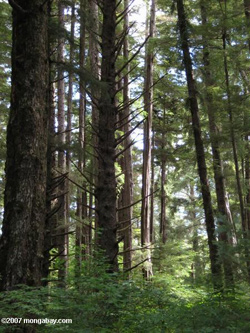Global warming is killing trees in California parks
Global warming is killing trees in California parks
mongabay.com
September 12, 2007
A new study ties a 22 percent increase in mortality among trees in the California Sierra Nevadas to a temperature-driven increase in drought.
The research, published in the October issue of Ecology Letters, suggests that California forests “may be poised for die-back if future climates continue to feature rising temperatures without compensating increases in precipitation.”
U.S. Geological Survey scientists, Phillip J. van Mantgem and Nathan L. Stephenson, measured the annual mortality of 21,338 trees in Sequoia and Yosemite national parks for more than two decades. The duration and extent of the study allowed the researchers to “correlate short-term variations in mortality with short-term variations in climate and other potential drivers of change” and assign “proximate causes of tree death… with a high degree of confidence, helping [them] identify probable mechanisms driving changes in mortality.”
Van Mantgem and Nathan L. Stephenson found that mortality rates increased for all trees combined, across most elevational zones and for each of two dominant
types of conifers. The deaths were linked to changes in water availability.

|
“The increase in mortality rates resulted from increases in deaths assigned to stress and biotic causes (such as insects and pathogens), which in turn paralleled a temperature driven increase in annual climatic water deficit (drought),” they write. “Other factors, such as changes in air pollution concentrations or internal stand conditions, were not correlated with mortality rates.”
“We conclude that these forests may be experiencing increasing deaths related to temperature-driven evaporative stress, potentially making them more vulnerable
to extensive die-back during otherwise normal periods of reduced precipitation,” they continue. “Our results highlight a need for better information regarding ongoing, climatically driven changes in other temperate forests.”
The study comes as other research reveals a marked increase in the number of forest fires occurring in the Western United States.
Writing in Science last July, Anthony Westerling, Hugo Hidalgo and Dan Cayan of Scripps Oceanography, along with Tom Swetnam of the University of Arizona, compiled a database of recent large western wildfires in the United States since 1970 and compared it with climate and land-surface data from the region. Their results show that large wildfire activity increased “suddenly and dramatically” in the 1980s with longer wildfire seasons and an increased number and more potent wildfires. The researchers found large fires occurred about four times more often during the 1987-2003 period than during the 1970-1986 period, and almost a seven-fold increase in the area of forested federal land burned during the latter period.
“We’re showing warming and earlier springs tying in with large forest fire frequencies. Lots of people think climate change and the ecological responses are 50 to 100 years away. But it’s not 50 to 100 years away — it’s happening now in forest ecosystems through fire,” said Swetnam at the time of publication.
CITATION: Phillip J. van Mantgem and Nathan L. Stephenson (2007). Apparent climatically induced increase of tree mortality rates in a temperate forest. Ecology Letters Vol. 10 Issue 10 October 2007